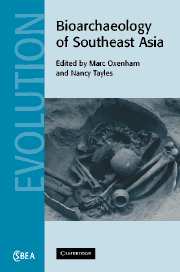Book contents
- Frontmatter
- Contents
- List of contributors
- Foreword: Emerging frontiers in the bioarchaeology of Southeast Asia
- Preface
- 1 Introduction: Southeast Asian bioarchaeology past and present
- Part I Morphological diversity, evolution and population relationships
- Part II Health, disease and quality of life
- 8 Subsistence change and dental health in the people of Non Nok Tha, northeast Thailand
- 9 Human biology from the bronze age to the iron age in the Mun River valley of northeast Thailand
- 10 Palaeodietary change among pre-state metal age societies in northeast Thailand: a study using bone stable isotopes
- 11 The oral health consequences of the adoption and intensification of agriculture in Southeast Asia
- 12 Cranial lesions on the late Pleistocene Indonesian Homo erectus Ngandong 7
- 13 ‘The predators within’: investigating the relationship between malaria and health in the prehistoric Pacific Islands
- Part III Conclusions
- Index
- References
9 - Human biology from the bronze age to the iron age in the Mun River valley of northeast Thailand
Published online by Cambridge University Press: 18 November 2009
- Frontmatter
- Contents
- List of contributors
- Foreword: Emerging frontiers in the bioarchaeology of Southeast Asia
- Preface
- 1 Introduction: Southeast Asian bioarchaeology past and present
- Part I Morphological diversity, evolution and population relationships
- Part II Health, disease and quality of life
- 8 Subsistence change and dental health in the people of Non Nok Tha, northeast Thailand
- 9 Human biology from the bronze age to the iron age in the Mun River valley of northeast Thailand
- 10 Palaeodietary change among pre-state metal age societies in northeast Thailand: a study using bone stable isotopes
- 11 The oral health consequences of the adoption and intensification of agriculture in Southeast Asia
- 12 Cranial lesions on the late Pleistocene Indonesian Homo erectus Ngandong 7
- 13 ‘The predators within’: investigating the relationship between malaria and health in the prehistoric Pacific Islands
- Part III Conclusions
- Index
- References
Summary
Introduction
Prehistory
Recent excavations of two sites in the Mun River valley in Northeast Thailand (Fig. 1.1, p. 5) as part of The Origins of Angkor Project have uncovered two large cemeteries. The site of Ban Lum Khao includes a bronze age cemetery in use between approximately 3400 and 2500 BP (Higham 2002). A 10 m × 14 m square was excavated to a maximum depth of 1.7 m on the edge of this mounded site as other areas of the site had been subjected to looting (Higham 2002). The cemetery site of Noen U-Loke, only a few kilometres to the west, is dated to the iron age, approximately 2300–2200 BP to 1700–1600 BP (Higham 2002). This iron age site was considerably more extensive than earlier sites and covered up to 12 ha (Higham 2002). A total of 220 m2 were excavated to a depth of 5 m (Higham 2002). Given the size of these sites, neither was excavated to their full extent. These two sites present an opportunity to compare health changes through time with the significant advantage that the populations lived in similar natural environments.
The aim of the Origins of Angkor Project is to investigate the social, cultural and technological developments in the Mun River valley that led to autonomous communities in this area undergoing the transition to more centralised and hierarchical societies (Higham and Thosarat 1998). The descendants of these communities built large-scale monuments and temples, some of which are still standing in the northeast today.
- Type
- Chapter
- Information
- Bioarchaeology of Southeast Asia , pp. 220 - 240Publisher: Cambridge University PressPrint publication year: 2006
References
- 9
- Cited by



